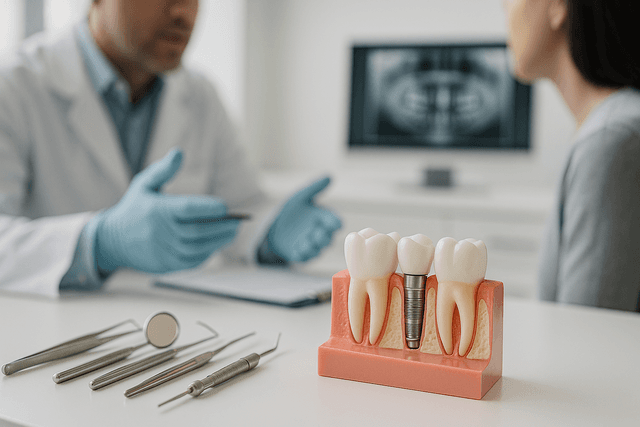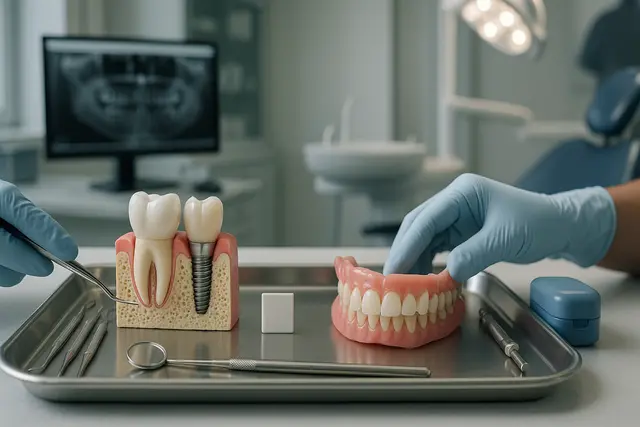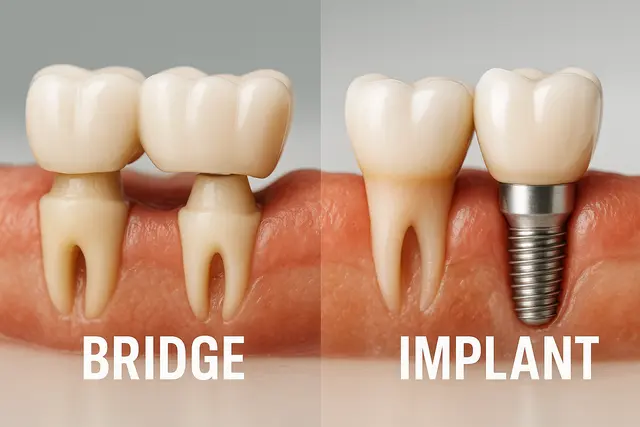Prosthodontics
5 min read
Oct 14, 2025
Step-by-Step Dental Implant Process: Demystifying the Procedure
Dental implants have revolutionized modern dentistry, offering a reliable and natural-looking solution for missing teeth. While the outcome is life-changing, the process can seem overwhelming at first. This guide breaks down each stage of the dental implant journey so you know exactly what to expect from start to finish.

Let’s be honest, getting a dental implant might sound more like a science fiction plot than a trip to the dentist. Words like abutment, osseointegration, and bone graft don’t exactly scream “relaxing experience.” But here’s the thing: with the right dental professional and a little know-how, the dental implant process is more “wow, that’s it?” than “yikes, what now?”.
If you’re missing one or more teeth and wondering if dental implants are for you, this step-by-step guide breaks down everything in real-world terms. No fluff. No scary jargon. Just the straight truth about how modern dentistry helps you get back your confident smile.
Initial Consultation with Your Dentist
It all starts with a chat. During your initial consultation, your dentist reviews your medical history, takes dental x-rays, and checks the health of your gum and jawbone. This isn’t just a quick peek, they’re crafting a treatment plan tailored to your mouth, whether you need one implant or several.
Being a good candidate for dental implants means your mouth’s in decent shape: healthy gum tissue, enough bone in your jaw, and no untreated gum disease. If your jawbone is too thin or soft? That’s where a bone graft might come into play.
Step 1: The First Stage of the Dental Implant Procedure
Here comes the big moment. Step 1 of the dental implant procedure is the surgical part, also called implant surgery. Don’t panic, it’s done under local anesthesia so you won’t feel a thing.
Your surgeon makes a small incision in your gum and surgically places the titanium implant post into your jawbone. This post acts like a tooth root and is the foundation for everything to come.
After this, your body needs time to heal. And not just any healing, this is where osseointegration kicks in. That’s the process where your bone and the implant fuse together. Think of it as nature and science shaking hands. This process called osseointegration can take two to six months, depending on your bone growth and overall health.
Step 2: Bone Graft and Healing Stages
Not everyone needs a bone graft, but if your jawbone needs a little reinforcement to support the implant, your dentist might suggest it. The graft helps strengthen the area so the metal implant can securely bond to your bone.
Healing stages happen over the course of several months. While this part requires a little patience, it’s what sets dental implants apart from quick fixes like dentures. You’re building something that lasts.
Step 3: Abutment Placement and Temporary Crown
Once the implant is fused with the bone, it’s time for Step 3: abutment placement. The abutment is a connector that sticks out just above the gum and connects the implant to your future crown.
This is usually a separate procedure, but much simpler than implant placement. The gum is reopened, the abutment is attached, and you’re stitched up again, but this time for a much shorter healing period.
During this phase, your dentist may give you a temporary crown that looks and functions like a natural tooth while your gum tissue settles around the implant. This isn’t just for looks, having a placeholder tooth helps with chewing and speaking too.
Step 4: Final Restoration and Permanent Crown
Now for the grand finale. Step 4 is when you finally receive your permanent crown. But not just any crown, it’s designed to match your natural teeth perfectly. Your dentist takes impressions of your mouth to ensure the crown fits just right, both in shape and color.
The crown is then either screwed into the implant or cemented onto the abutment, depending on the type of implant and your specific needs. Either way, it marks the end of your step-by-step dental implant journey.
The final restoration feels, looks, and works like a real tooth. You can bite into an apple, smile for photos, and never worry about it slipping like a denture.
Understanding the Full Dental Implant Process Timeline
So how long does this all take? The full dental implant process timeline varies from patient to patient. On average, you’re looking at a course of several months from consultation to final crown.
Healing stages, the need for a bone graft, and the number of implants can all influence your implant timeline. But here’s the tradeoff, dental implants offer a long-term, rock-solid solution to replace missing teeth.
Why Dental Implants Are the Gold Standard in Tooth Replacement
Dental implants are artificial teeth, yes. But calling them that undersells them. A tooth implant isn’t just a cosmetic fix, it restores function and preserves oral health.
Unlike dentures that sit on top of your gums, dental implants are surgically embedded into the jawbone. This prevents bone loss and keeps your facial structure intact. Plus, they don’t bother the surrounding teeth like bridges sometimes do.
They’re also incredibly easy to care for:
Brush, floss, and smile, it’s that simple.
No soaking, no adhesives, no awkward moments.
One Tooth or Many, Dental Implants Work for All Smiles
Whether you need a single tooth replacement or a full dental makeover, the step dental implant procedure can be customized. You might have one implant or multiple implants topped with crowns, bridges, or even implant-supported dentures.
It all depends on your goals, budget, and what your dentist recommends. Implant dentistry has come a long way, and the options today are more advanced than ever.
A Look at the Implant Placement Itself
Let’s circle back for a second. When we say the implant is placed, we’re talking about surgically embedding a titanium post into the jaw. This metal implant fuses with the bone, forming a base that can handle everything from a single tooth to full arch restorations.
The process of placing the implant takes skill, precision, and experience. It’s not something you want to cut corners on, which is why choosing a qualified dental professional matters.
What Happens During the Dental Implant Procedure?
The dental implant procedure begins with a surgical step where a titanium post is placed into your jawbone. This post acts as a tooth root and sets the foundation for your new tooth. Once in place, your bone begins the osseointegration process, fusing with the implant to create a strong, permanent hold. After healing, an abutment is added to connect the post to your crown, which is later customized to match your natural teeth. The process can take a few months but results in a long-lasting solution that looks and feels natural.
Do I Need a Bone Graft Before Getting a Dental Implant?
You may need a bone graft if your jawbone is too thin or soft to support a dental implant. Bone grafting strengthens the implant site and allows for proper fusion between the bone and the titanium post. While this adds time to your treatment plan, it significantly improves the success rate of the implant. Your dentist will determine this during your initial consultation based on X-rays and an exam of your oral health and bone structure.
How Long Does the Full Dental Implant Process Take?
The full dental implant process typically spans several months, from initial consultation to the final crown placement. Healing time after the implant surgery (for osseointegration) can take two to six months. If a bone graft is required, it adds more healing time. Once healed, an abutment is placed, followed by a temporary and then permanent crown. The timeline varies per patient but prioritizes long-term stability and function.
Why Are Dental Implants Considered a Long-Term Tooth Replacement Option?
Dental implants are embedded directly into the jawbone, which prevents bone loss and provides superior support compared to dentures or bridges. Because the titanium post fuses with the bone, it mimics the strength and stability of natural tooth roots. With proper care, including brushing, flossing, and regular dental visits, implants can last a lifetime, making them the gold standard for restoring both function and aesthetics in tooth replacement.
Read Next
Related Posts

Prosthodontics
Implant vs. Dentures Pros and Cons: A Deep Dive into Modern Solutions
Missing teeth can impact more than just your smile, they can affect how you eat, speak, and feel about yourself. Fortunately, modern dentistry offers two leading solutions to bring back both function and confidence: dentures and dental implants. Understanding the pros and cons of each can help you make the choice that fits your needs, lifestyle, and budget.
7 min read
Oct 17, 2025

Prosthodontics
Full Mouth Implants vs. Dentures: Which Is Better for You?
When it comes to replacing missing teeth, the choice between full mouth dental implants and dentures can be overwhelming. Each option has its own set of benefits, limitations, and long-term considerations, making it essential to understand what works best for your needs, health, and lifestyle.
5 min read
Oct 17, 2025

Prosthodontics
Tooth-Supported Bridge vs. Implant Comparison: Benefits, Drawbacks, and Insights
Deciding between a dental bridge and a dental implant can feel overwhelming, especially when both options promise to restore your smile and improve oral function. Each solution comes with its own set of benefits, considerations, and ideal use cases, making it essential to understand how they compare before choosing what’s right for you.
6 min read
Oct 17, 2025
Don’t have time to research every dentist around you?
See why 30k+ patients trusted us